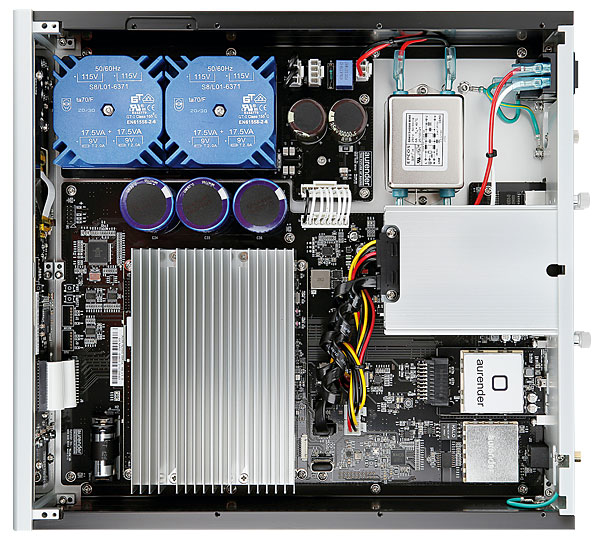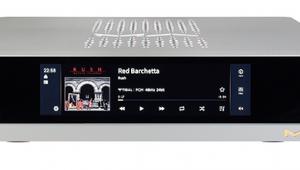Aurender N200 Network Audio Transport

 In raw form this is a digital streamer/network bridge governed by the Conductor app, but add optional SSD storage and the N200 becomes a fully-fledged music library
In raw form this is a digital streamer/network bridge governed by the Conductor app, but add optional SSD storage and the N200 becomes a fully-fledged music library
Music storage: it can be a thorny subject, not least because those network products offering internal capacity for your library tend either to have fixed, non-expandable storage, or offer the option of dealer-installed drives. The cost of such storage is usually high, too – okay, not 'adding capacity at time of ordering your new Apple computer high', where an extra Terabyte can cost you £400, but still at prices to have you looking at HDDs on the likes of Amazon and scratching your head.
Not so with the Aurender N200, available in silver or black at £6700. As supplied it has no storage capacity aside from the 240GB NVMe SSD used for caching music for playback, of which more later. Instead, two slots on the rear take 2.5in HDDs or SSDs, installed by the user to suit their needs. And that's a good thing for two reasons: one is that you can buy your own drives at sensible prices – think just over £100 for a 1TB Samsung SSD, less if you go for the likes of a Seagate Barracuda HDD – and the other is that Aurender has made it simple to install the storage.
Taming Of The Screw
In fact, armed with a Samsung SSD, I was so delighted with the speed and ease of installation that I took it out again and timed myself at less than a minute to fit it once more. Switch off the N200, undo two thumbscrews on the rear panel, slide out the tray, drop in the drive – the N200 will take any 2.5in storage up to 7mm thick – then slide the tray in and do up the screws. Power up again and job done – the N200 will format the storage if required, and you're good to play. No tools, no fiddling with tiny screws you'll inevitably drop – that's all there is to it.
Clearly the Korean designers of this music streamer/server have got things thoroughly thought through, and in the N200 they've further refined a design we've admired before, for example in the £19,000 A30 CD ripper/player/server [HFN Dec '19]. The N200 may be half the price of that monster high-end unit, but it gives away little apart from an optical disc-drive. Its design and audio capability have been substantially revised for this relatively compact model, from the mainboard processor to the PSU, which even has its own uninterruptible super capacitor provision, allowing an orderly shutdown in case the mains fails. See what I mean about thinking things through…?
However, Aurender's N200 isn't quite the complete one-stop shop. For a start it has no built-in digital-to-analogue conversion, and so needs to be used into either a suitable DAC – it has outputs on USB and coaxial S/PDIF – or an amp/preamp with onboard conversion. And while it comes with a simple quartet of front-panel controls, operation via the Aurender Conductor app is much slicker and also makes over-air firmware updates a breeze.
The Inside Story
At the heart of the N200 is a new low-power Intel Quad-Core processor, low-noise linear power supply and increased system memory for smoother operation. The rear-panel Ethernet connection, adjacent to two further USB ports to which external storage can be added, is double-isolated to keep network noise at bay, and the whole thing is poured into a high-quality machined aluminium housing with a large, bright, clear display.

Aurender's player is built around the principle of caching music on its way to the output, using that 240GB internal SSD to avoid any glitches or drop-outs whether playing from (your) internal hard-drives, external USB storage or online services such as Qobuz and Tidal, both of which are supported here. In fact, once music is summoned from internal or external drives to the cache, the 'supplying' drive is idled to optimise audio performance.
I've already mentioned that the N200's linear PSU is backed-up by a super capacitor UPS to cover any mains failures. Having had more than one device of this kind 'bricked' by a power outage in the past, that seems like a sensible provision, along with the gentle shutdown procedure the unit executes when turning it off. This is, after all, a computer at heart.
You could, of course, use the N200 simply as a means of accessing streaming services, where I have to say it sounds very good indeed, even if £6700 is quite a lot of expense just to listen to your playlists on Qobuz or Tidal (for which MQA decoding is available as an extra-cost download add-on). However, like all its products, the N200 isn't Roon-compatible, Aurender saying that 'Roon is a very CPU-demanding piece of software, and our servers are intentionally designed to be minimalistic where processing is concerned'. The company believes this is 'a big reason why your Aurender sounds so good', adding that its own playback software is custom engineered and tailored to its hardware. You can, however, 'cast' to the player from a Roon installation, though this is via AirPlay and thus really only designed for casual listening.























































